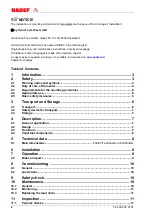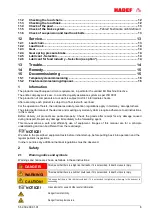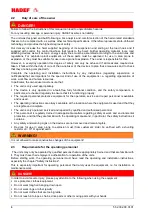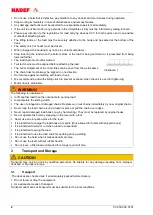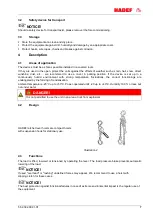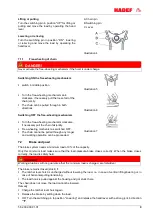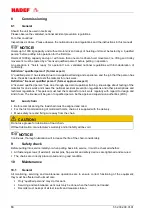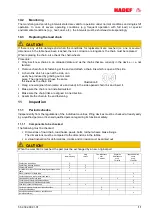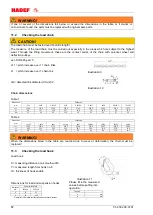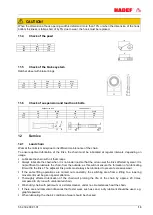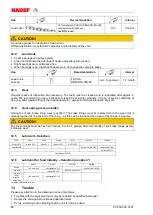
5.52.302.00.01.01
15
Secure the working area of moving parts of the unit.
Please read the chapter "Safety instructions".
Notes on the repair of faults are found in the following table.
For the repair of failures please contact our service department.
CAUTION!
Trouble caused by wear or damage to parts such as wire ropes, chains, chain wheels, axes, bearings,
brake parts, etc., must be remedied by replacing the parts with original spare parts.
14
Remedy
Check the ratchet lever hoist by listening to the noise it makes:
Lifting: Move the lever forward and backwards - it should make click
Lowering: Only move the lever backwards not forward - it should make click
Problem
Cause
Remedy
Load is not lifted
Overload
Reduce the load to nominal load
Load got stuck
Set the load free again
Brake linings are worn
Do maintenance and
exchange the brake linings
Load chain is twisted
Align the load chain
Defect of chain, gear or chain wheels
Do maintenance and replace defective parts by original
spare parts
Pawl does not engage properly
Check the pawl and replace it if necessary
Switching pin - wrong position
Chose correct position of switching pin
Pawl spring is missing
Do maintenance and replace defective parts by original
spare parts
It is difficult to lift the load
Overload
Reduce the load to nominal load
Dirty chains, gear or chain wheels
Do maintenance, lubricate chains, gear and chain wheels
Defect of chain, gear or chain wheels
Do maintenance and replace defective parts by original
spare parts
Load is lifted with interruptions
Pawl spring is missing or defective
Do maintenance and replace defective parts by original
spare parts
Hoist does not lift without load
Brake spring is missing
Do maintenance and replace defective parts by original
spare parts
Hoist does not lift the whole distance long
Hook stucks, chain is twisted
Place hooks and chains in correct position
The brake remains closed (stuck),
the hoist was unloaded without lowering the load
Suspend the load again, lower the load, unload the hoist
The load hook was pulled against the housing and got
stuck there.
Release the hook, suspend the load again, lower the load,
unload the hoist.
Hoist does not lower the load
Brake too tight
Turn the switching pin to position "▼" resp. "DN" and
move the hand lever while pulling the chain at the load
side.
Brake without function due to rust
Effect periodic inspection and replace rusty parts.
Load slips down partially during lowering
Foreign-object between the brake discs
Remove the foreign-object, clean the surface (Do not
lubricate.)
Load slips down during lowering
Brake lining is missing, installed incorrectly or worn
Bremsbelages
Replace the brake lining resp. install it correctly
Switching pin does not function
Defect or deformation
Check and replace, if necessary.
Load slips down when the switching pin is switched to
free-wheeling mechanism.
Chain spring is missing or defective.
Do maintenance and replace defective parts by original
spare parts.
Ratchet lever blocked when lifting and lowering *)
Lock has triggered
Device must be repaired by a qualified person
*) nur bei Geräten mit Verriegelungsmechanismus
15
Decommissioning
WARNING!
It is essential that the following points are observed in order to prevent damage to the equipment or critical
injury when the device is being decommissioned:
It is mandatory that all steps for decommissioning the machine are carried out in the indicated sequence:
First secure the working area for decommissioning, leaving plenty of space.
Read the chapter "Safety instructions".
Disassembly is carried out in reverse order to the assembly.
Please make sure that all operating material is disposed of in accordance with environmental regulations.


